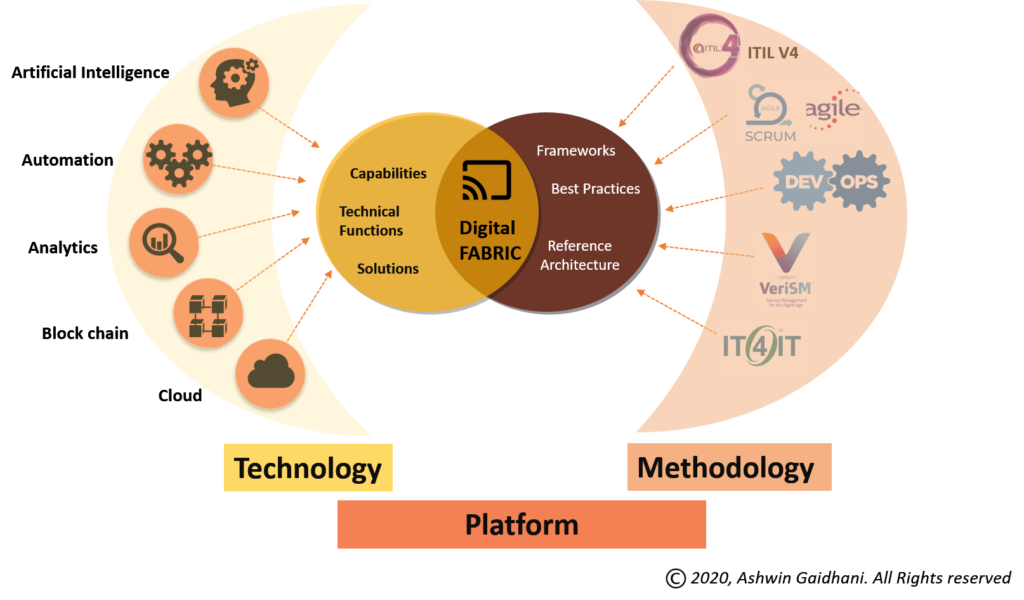
THE PLATFORM
Technology is the science of combining mindware (Purpose), hardware(metal), and software (programs) to answer real-life situations (not always challenges). Maturity of customer needs and the degree of product relevance call for innovation to design new results, use case, and aptitudes.
Technology always had this bifold character where one facet matures to self improvise on the capability. The second where the matured capability turns into a domain that offshoots to become an independent function to merge with the adjacent heterogeneous alternatives.

Digital FABRIC is all about this idea of the 21st century to address extensive, complex, and novel circumstances. I have substituted technology with the Platform presenting the new personification of components that have a role as an individual and as part of a group. A platform should sport capability and comprehensiveness as its two most significant characteristics.
Most enterprises are switching from the technology-led mindset to developing a platform, which is the core foundation of the Digital transformation initiative and an essential ingredient of Digital FABRIC.
Capability: Technology has disposed itself from a singular point of expertise to multi-dimensional competencies that resolve many small but vital business aspects. Hence these capabilities are now the most relevant to our enterprises. One cannot achieve the entire objective (five senses complete the experience aspect in us and still need supplementing parts to form the body). Similarly, A platform is the assimilation of capabilities chosen and matured to a level of requirement and then used to compile the envisioned solution or product.

Every enterprise should feverishly work towards building an exclusive personalized platform that constitutes of all other four work design constituents. Capabilities have moved away from a concentrated architecture to a diversified and segmented progression that is universal. Many illustrations suitably depict the transition of strategy and vision, which is led by the industry, technology, and consumers.
- Amazon-AWZ, GCP, AZURE, ServiceNow, LinkedIn, Workday, Salesforce are coveted illustrations in their respective areas of a complete platform in the making.
- Not only the technology but new versions of frameworks are also stressing on onboarding and involving all stakeholders to ensure a holistic approach. (ITIL V4, SCRUM, IT4IT 2.1)
- There are no more rigid boundaries between technologies to isolate themselves; on the contrary, adversaries are forging new relations to address unprecedented times or unparalleled solutions. (X + AWS, Y + Wipro HOLMES)
- AI platform, Automation platform, Data platform, Cloud platforms are now practically converging into a utilitarian platform.
Capabilities are symbiotic moving parts of the system that generate constant value to every transaction.
Comprehensiveness: If you carefully observe, the innermost layer (People) and outermost layer (Partnership) relies on the human connection, which cannot be emulated by any other entity. All other constituents (Process, Platform {Technology}, Product) are virtual and abiotic, which can endure digitally.
Comprehensiveness is a strategic perspective that involves organizational change management to start building a platform to hold the institution’s future aspirations. This has a lot to do with the leadership and vision to begin this work of defining future scope, including new affairs, diversification, disruption to create new dimensions of an imagined enterprise. The intention should be to build a techno-platform that is future proof and accommodating to almost any component that can add value.

These three attributes are bound with each other, and incorporation of all is imperative to build a comprehensive platform. We need an assemblage of individuals with the right skill set, mindset, and toolset with roles like enterprise architects, methodology experts, product specialists, and business markets economists to contribute to the framework. The architects of this Platform should envision the new possibilities of the future, which can unite and add a new perspective.
The entire technology ecosystem is segmented into capability, functions, products, systems, and components with different maturity levels to form a hybrid offering that addresses more than one complicated challenges.
Not so long ago, we chose and defined human resources and technology capability by the level-hands experience. The technology was segmented, and resources had to pick and choose to build an identity in that one function, which was only possible only after few years and few certifications.
Not so far away – Almost all technology offerings have transformed into a cluster that is looking not only at directly related sub-domains but adjacent and complementing areas to create one output, which is part of a platform where multiple constituents collaborate to fulfill the final aspiration and experience as per time.

The focus is not on how to run or use the technology, but to repurpose and interpret the right fitment and experience is the prominent skill in today’s world.
THE PLATFORM is about associating with the next best, smartest, and distinct things to recreate value proposition. Every constituent’s end goal is to reside on one single Business Transformation platform, which is perfectly aligned, thoughtfully placed, and balanced work design constituent to keep an organization’s initiatives and purpose relevant.
[1. Arriving @ the – Digital FABRIC 2. Digital FABRIC – Outlining Intricacies 3. Digital Fabric – The people: Being Digital and not Doing Digital 4. Digital Fabric: The Process – It is all about PEOPLE & PROCESS]



Leave a Reply
You must be logged in to post a comment.